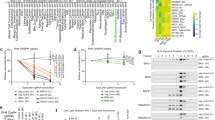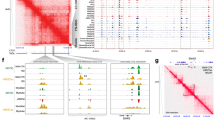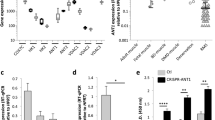Abstract
Rhabdomyosarcoma (RMS) is the commonest soft-tissue sarcoma in childhood and is characterized by expression of myogenic proteins, including the transcription factors MyoD and myogenin. There are two main subgroups, embryonal RMS and alveolar RMS (ARMS). Most ARMS are associated with chromosomal translocations that have breakpoints in introns of either PAX3 or PAX7, and FOXO1A. These translocations create chimeric transcription factors termed PAX3/FOXO1A and PAX7/FOXO1A respectively. Upon ectopic PAX3/FOXO1A expression, together with other genetic manipulation in mice, both differentiating myoblasts and satellite cells (the resident stem cells of postnatal muscle) can give rise to tumours with ARMS characteristics. As PAX3 and PAX7 are part of transcriptional networks that regulate muscle stem cell function in utero and during early postnatal life, PAX3/FOXO1A and PAX7/FOXO1A may subvert normal PAX3 and PAX7 functions. Here we examined how PAX3/FOXO1A and PAX7/FOXO1A affect myogenesis in satellite cells. PAX3/FOXO1A or PAX7/FOXO1A inhibited myogenin expression and prevented terminal differentiation in murine satellite cells: the same effect as dominant-negative (DN) Pax3 or Pax7 constructs. The transcription of MyoD-target genes myogenin and muscle creatine kinase were suppressed by PAX3/FOXO1A or PAX7/FOXO1A in C2C12 myogenic cells again as seen with Pax3/7DN. PAX3/FOXO1A or PAX7/FOXO1A did not inhibit the transcriptional activity of MyoD by perturbing MyoD expression, localization, phosphorylation or interaction with E-proteins. Chromatin immunoprecipitation on the myogenin promoter showed that PAX3/FOXO1A or PAX7/FOXO1A did not prevent MyoD from binding. However, PAX3/FOXO1A or PAX7/FOXO1A reduced occupation of the myogenin promoter by RNA polymerase II and decreased acetylation of histone H4, but did not directly bind to the myogenin promoter. Together, these observations reveal that PAX3/FOXO1A and PAX7/FOXO1A act to prevent myogenic differentiation via suppression of the transcriptional activation of MyoD-target genes.
This is a preview of subscription content, access via your institution
Access options
Subscribe to this journal
Receive 50 print issues and online access
$259.00 per year
only $5.18 per issue
Buy this article
- Purchase on Springer Link
- Instant access to full article PDF
Prices may be subject to local taxes which are calculated during checkout







Similar content being viewed by others
References
Barr FG . Gene fusions involving PAX and FOX family members in alveolar rhabdomyosarcoma. Oncogene 2001; 20: 5736–5746.
Miller PJ, Hollenbach AD . The oncogenic fusion protein Pax3-FKHR has a greater post-translational stability relative to Pax3 during early myogenesis. Biochim Biophys Acta 2007; 1770: 1450–1458.
Fredericks WJ, Galili N, Mukhopadhyay S, Rovera G, Bennicelli J, Barr FG et al. The PAX3-FKHR fusion protein created by the t(2;13) translocation in alveolar rhabdomyosarcomas is a more potent transcriptional activator than PAX3. Mol Cell Biol 1995; 15: 1522–1535.
Davicioni E, Finckenstein FG, Shahbazian V, Buckley JD, Triche TJ, Anderson MJ . Identification of a PAX-FKHR gene expression signature that defines molecular classes and determines the prognosis of alveolar rhabdomyosarcomas. Cancer Res 2006; 66: 6936–6946.
Begum S, Emami N, Cheung A, Wilkins O, Der S, Hamel PA . Cell-type-specific regulation of distinct sets of gene targets by Pax3 and Pax3/FKHR. Oncogene 2005; 24: 1860–1872.
Bennicelli JL, Advani S, Schafer BW, Barr FG . PAX3 and PAX7 exhibit conserved cis-acting transcription repression domains and utilize a common gain of function mechanism in alveolar rhabdomyosarcoma. Oncogene 1999; 18: 4348–4356.
Epstein JA, Song B, Lakkis M, Wang C . Tumor-specific PAX3-FKHR transcription factor, but not PAX3, activates the platelet-derived growth factor alpha receptor. Mol Cell Biol 1998; 18: 4118–4130.
Buckingham M, Relaix F . The role of Pax genes in the development of tissues and organs: Pax3 and Pax7 regulate muscle progenitor cell functions. Annu Rev Cell Dev Biol 2007; 23: 645–673.
Relaix F, Rocancourt D, Mansouri A, Buckingham M . A Pax3/Pax7-dependent population of skeletal muscle progenitor cells. Nature 2005; 435: 948–953.
Lepper C, Conway SJ, Fan CM . Adult satellite cells and embryonic muscle progenitors have distinct genetic requirements. Nature 2009; 460: 627–631.
Relaix F, Montarras D, Zaffran S, Gayraud-Morel B, Rocancourt D, Tajbakhsh S et al. Pax3 and Pax7 have distinct and overlapping functions in adult muscle progenitor cells. J Cell Biol 2006; 172: 91–102.
Zammit PS, Relaix F, Nagata Y, Ruiz AP, Collins CA, Partridge TA et al. Pax7 and myogenic progression in skeletal muscle satellite cells. J Cell Sci 2006; 119 (Pt 9): 1824–1832.
Zammit PS, Golding JP, Nagata Y, Hudon V, Partridge TA, Beauchamp JR . Muscle satellite cells adopt divergent fates: a mechanism for self-renewal? J Cell Biol 2004; 166: 347–357.
Relaix F, Polimeni M, Rocancourt D, Ponzetto C, Schafer BW, Buckingham M . The transcriptional activator PAX3-FKHR rescues the defects of Pax3 mutant mice but induces a myogenic gain-of-function phenotype with ligand-independent activation of Met signaling in vivo. Genes Dev 2003; 17: 2950–2965.
Cao L, Yu Y, Bilke S, Walker RL, Mayeenuddin LH, Azorsa DO et al. Genome-wide identification of PAX3-FKHR binding sites in rhabdomyosarcoma reveals candidate target genes important for development and cancer. Cancer Res 2010; 70: 6497–6508.
Tapscott SJ, Thayer MJ, Weintraub H . Deficiency in rhabdomyosarcomas of a factor required for MyoD activity and myogenesis. Science 1993; 259: 1450–1453.
Weintraub M, Kalebic T, Helman LJ, Bhatia KG . Disruption of the MyoD/p21 Pathway in Rhabdomyosarcoma. Sarcoma 1997; 1: 135–141.
Arndt CA, Crist WM . Common musculoskeletal tumors of childhood and adolescence. N Engl J Med 1999; 341: 342–352.
Gurney JG, Young JL, Roffers SD, Smith MA, Bunin GR . Soft Tissue Sarcomas. In: Ries LAG SM, Gurney JG, Linet M, Tamra T, Young JL, Bunin GR (eds). Cancer Incidence and Survival Among Children and Adolescents: United States SEER Program 1975–1995. National Cancer Institute: Bethesda, MD, 1999, pp 111–123.
Cui S, Hano H, Harada T, Takai S, Masui F, Ushigome S . Evaluation of new monoclonal anti-MyoD1 and anti-myogenin antibodies for the diagnosis of rhabdomyosarcoma. Pathol Int 1999; 49: 62–68.
Maroto M, Reshef R, Munsterberg AE, Koester S, Goulding M, Lassar AB . Ectopic Pax-3 activates MyoD and Myf-5 expression in embryonic mesoderm and neural tissue. Cell 1997; 89: 139–148.
Keller C, Hansen MS, Coffin CM, Capecchi MR . Pax3:Fkhr interferes with embryonic Pax3 and Pax7 function: implications for alveolar rhabdomyosarcoma cell of origin. Genes Dev 2004; 18: 2608–2613.
Nishijo K, Hosoyama T, Bjornson CR, Schaffer BS, Prajapati SI, Bahadur AN et al. Biomarker system for studying muscle, stem cells, and cancer in vivo. FASEB J 2009; 23: 2681–2690.
Hettmer S, Wagers AJ . Muscling in: uncovering the origins of rhabdomyosarcoma. Nat Med 2010; 16: 171–173.
Gnocchi VF, White RB, Ono Y, Ellis JA, Zammit PS . Further characterisation of the molecular signature of quiescent and activated mouse muscle satellite cells. PLoS ONE 2009; 4: e5205.
Epstein JA, Lam P, Jepeal L, Maas RL, Shapiro DN . Pax3 inhibits myogenic differentiation of cultured myoblast cells. J Biol Chem 1995; 270: 11719–11722.
Weintraub H, Tapscott SJ, Davis RL, Thayer MJ, Adam MA, Lassar AB et al. Activation of muscle-specific genes in pigment, nerve, fat, liver, and fibroblast cell lines by forced expression of MyoD. Proc Natl Acad Sci USA 1989; 86: 5434–5438.
Russo S, Tomatis D, Collo G, Tarone G, Tato F . Myogenic conversion of NIH3T3 cells by exogenous MyoD family members: dissociation of terminal differentiation from myotube formation. J Cell Sci 1998; 111 ( Pt 6): 691–700.
Graf Finckenstein F, Shahbazian V, Davicioni E, Ren YX, Anderson MJ . PAX-FKHR function as pangenes by simultaneously inducing and inhibiting myogenesis. Oncogene 2008; 27: 2004–2014.
Khan J, Bittner ML, Saal LH, Teichmann U, Azorsa DO, Gooden GC et al. cDNA microarrays detect activation of a myogenic transcription program by the PAX3-FKHR fusion oncogene. Proc Natl Acad Sci USA 1999; 96: 13264–13269.
Scuoppo C, Riess I, Schmitt-Ney M, Allegra P, Forni PE, Bersani F et al. The oncogenic transcription factor PAX3-FKHR can convert fibroblasts into contractile myotubes. Exp Cell Res 2007; 313: 2308–2317.
Berkes CA, Tapscott SJ . MyoD and the transcriptional control of myogenesis. Semin Cell Dev Biol 2005; 16: 585–595.
Montarras D, Morgan J, Collins C, Relaix F, Zaffran S, Cumano A et al. Direct isolation of satellite cells for skeletal muscle regeneration. Science 2005; 309: 2064–2067.
Wei Q, Paterson BM . Regulation of MyoD function in the dividing myoblast. FEBS Lett 2001; 490: 171–178.
Tapscott SJ . The circuitry of a master switch: Myod and the regulation of skeletal muscle gene transcription. Development 2005; 132: 2685–2695.
Collins CA, Gnocchi VF, White RB, Boldrin L, Perez-Ruiz A, Relaix F et al. Integrated functions of Pax3 and Pax7 in the regulation of proliferation, cell size and myogenic differentiation. PLoS ONE 2009; 4: e4475.
Relaix F, Rocancourt D, Mansouri A, Buckingham M . Divergent functions of murine Pax3 and Pax7 in limb muscle development. Genes Dev 2004; 18: 1088–1105.
Tajbakhsh S, Rocancourt D, Cossu G, Buckingham M . Redefining the genetic hierarchies controlling skeletal myogenesis: Pax-3 and Myf-5 act upstream of MyoD. Cell 1997; 89: 127–138.
Dilworth FJ, Seaver KJ, Fishburn AL, Htet SL, Tapscott SJ . In vitro transcription system delineates the distinct roles of the coactivators pCAF and p300 during MyoD/E47-dependent transactivation. Proc Natl Acad Sci USA 2004; 101: 11593–11598.
Guo K, Wang J, Andres V, Smith RC, Walsh K . MyoD-induced expression of p21 inhibits cyclin-dependent kinase activity upon myocyte terminal differentiation. Mol Cell Biol 1995; 15: 3823–3829.
Halevy O, Novitch BG, Spicer DB, Skapek SX, Rhee J, Hannon GJ et al. Correlation of terminal cell cycle arrest of skeletal muscle with induction of p21 by MyoD. Science 1995; 267: 1018–1021.
Otten AD, Firpo EJ, Gerber AN, Brody LL, Roberts JM, Tapscott SJ . Inactivation of MyoD-mediated expression of p21 in tumor cell lines. Cell Growth Differ 1997; 8: 1151–1160.
Song A, Wang Q, Goebl MG, Harrington MA . Phosphorylation of nuclear MyoD is required for its rapid degradation. Mol Cell Biol 1998; 18: 4994–4999.
Zhang L, Wang C . Identification of a new class of PAX3-FKHR target promoters: a role of the Pax3 paired box DNA binding domain. Oncogene 2007; 26: 1595–1605.
Bajard L, Relaix F, Lagha M, Rocancourt D, Daubas P, Buckingham ME . A novel genetic hierarchy functions during hypaxial myogenesis: Pax3 directly activates Myf5 in muscle progenitor cells in the limb. Genes Dev 2006; 20: 2450–2464.
Lagha M, Kormish JD, Rocancourt D, Manceau M, Epstein JA, Zaret KS et al. Pax3 regulation of FGF signaling affects the progression of embryonic progenitor cells into the myogenic program. Genes Dev 2008; 22: 1828–1837.
Ono Y, Boldrin L, Knopp P, Morgan JE, Zammit PS . Muscle satellite cells are a functionally heterogeneous population in both somite-derived and branchiomeric muscles. Dev Biol 2010; 337: 29–41.
Horst D, Ustanina S, Sergi C, Mikuz G, Juergens H, Braun T et al. Comparative expression analysis of Pax3 and Pax7 during mouse myogenesis. Int J Dev Biol 2006; 50: 47–54.
Kelly KM, Womer RB, Sorensen PH, Xiong QB, Barr FG . Common and variant gene fusions predict distinct clinical phenotypes in rhabdomyosarcoma. J Clin Oncol 1997; 15: 1831–1836.
del Peso L, Gonzalez VM, Hernandez R, Barr FG, Nunez G . Regulation of the forkhead transcription factor FKHR, but not the PAX3-FKHR fusion protein, by the serine/threonine kinase Akt. Oncogene 1999; 18: 7328–7333.
L’Honore A, Rana V, Arsic N, Franckhauser C, Lamb NJ, Fernandez A . Identification of a new hybrid serum response factor and myocyte enhancer factor 2-binding element in MyoD enhancer required for MyoD expression during myogenesis. Mol Biol Cell 2007; 18: 1992–2001.
Ornatsky OI, Andreucci JJ, McDermott JC . A dominant-negative form of transcription factor MEF2 inhibits myogenesis. J Biol Chem 1997; 272: 33271–33278.
Yang Z, MacQuarrie KL, Analau E, Tyler AE, Dilworth FJ, Cao Y et al. MyoD and E-protein heterodimers switch rhabdomyosarcoma cells from an arrested myoblast phase to a differentiated state. Genes Dev 2009; 23: 694–707.
Saccone V, Puri PL . Epigenetic regulation of skeletal myogenesis. Organogenesis 2010; 6: 48–53.
Sartorelli V, Puri PL, Hamamori Y, Ogryzko V, Chung G, Nakatani Y et al. Acetylation of MyoD directed by PCAF is necessary for the execution of the muscle program. Mol Cell 1999; 4: 725–734.
Nakajima T, Uchida C, Anderson SF, Lee CG, Hurwitz J, Parvin JD et al. RNA helicase A mediates association of CBP with RNA polymerase II. Cell 1997; 90: 1107–1112.
el-Deiry WS, Tokino T, Waldman T, Oliner JD, Velculescu VE, Burrell M et al. Topological control of p21WAF1/CIP1 expression in normal and neoplastic tissues. Cancer Res 1995; 55: 2910–2919.
Spitz F, Demignon J, Porteu A, Kahn A, Concordet JP, Daegelen D et al. Expression of myogenin during embryogenesis is controlled by Six/sine oculis homeoproteins through a conserved MEF3 binding site. Proc Natl Acad Sci USA 1998; 95: 14220–14225.
Acknowledgements
We thank Frederic Barr for PAX3-FOXO1A and PAX7-FOXO1A, and Stephen Tapscott for pclBabe-MyoD∼E12 and pCS2-MCK-luciferase. We acknowledge colleagues who shared antibodies through the Developmental Studies Hybridoma Bank maintained by the University of Iowa. FC was funded by the Association of International Cancer Research (07-0151). The laboratory of PSZ is also supported by The Wellcome Trust (085137/Z/08/Z), The Medical Research Council and OPTISTEM (Grant 223098) from the European Commission FP7. JEM is supported by a Wellcome Trust University Award. The laboratory of FR is supported by the INSERM Avenir Program, AFM, INCa, LNCC, ARC and FP7 ENDOSTEM (Grant 241440).
Author information
Authors and Affiliations
Corresponding author
Ethics declarations
Competing interests
The authors declare no conflict of interest.
Additional information
Supplementary Information accompanies the paper on the Oncogene website
Rights and permissions
About this article
Cite this article
Calhabeu, F., Hayashi, S., Morgan, J. et al. Alveolar rhabdomyosarcoma-associated proteins PAX3/FOXO1A and PAX7/FOXO1A suppress the transcriptional activity of MyoD-target genes in muscle stem cells. Oncogene 32, 651–662 (2013). https://doi.org/10.1038/onc.2012.73
Received:
Revised:
Accepted:
Published:
Issue Date:
DOI: https://doi.org/10.1038/onc.2012.73
Keywords
This article is cited by
-
Master regulators of skeletal muscle lineage development and pluripotent stem cells differentiation
Cell Regeneration (2021)
-
A human Myogenin promoter modified to be highly active in alveolar rhabdomyosarcoma drives an effective suicide gene therapy
Cancer Gene Therapy (2021)
-
BAF complexes drive proliferation and block myogenic differentiation in fusion-positive rhabdomyosarcoma
Nature Communications (2021)
-
The PAX3-FOXO1 oncogene alters exosome miRNA content and leads to paracrine effects mediated by exosomal miR-486
Scientific Reports (2019)
-
A novel PAX7 10-bp indel variant modulates promoter activity, gene expression and contributes to different phenotypes of Chinese cattle
Scientific Reports (2018)



